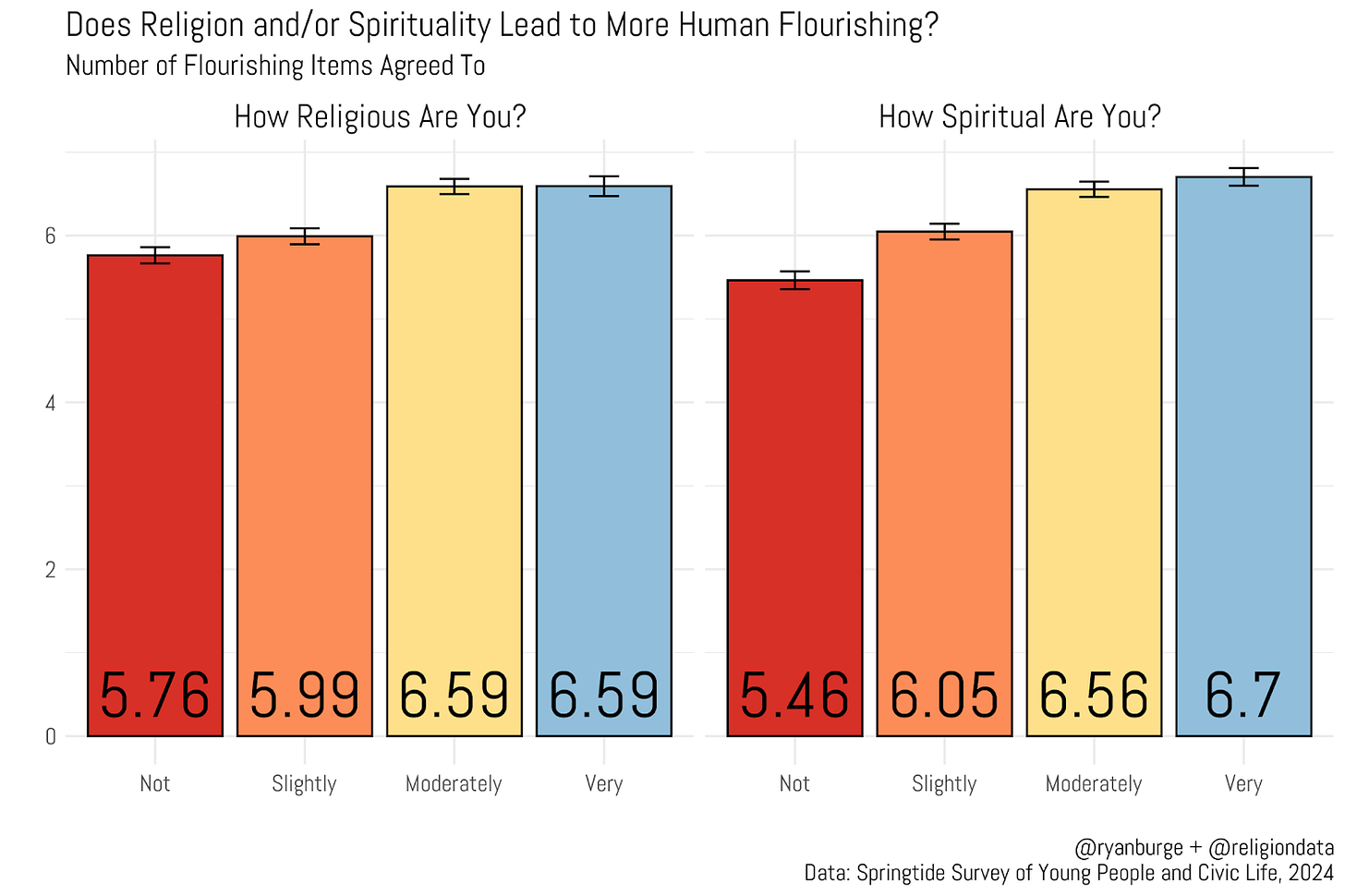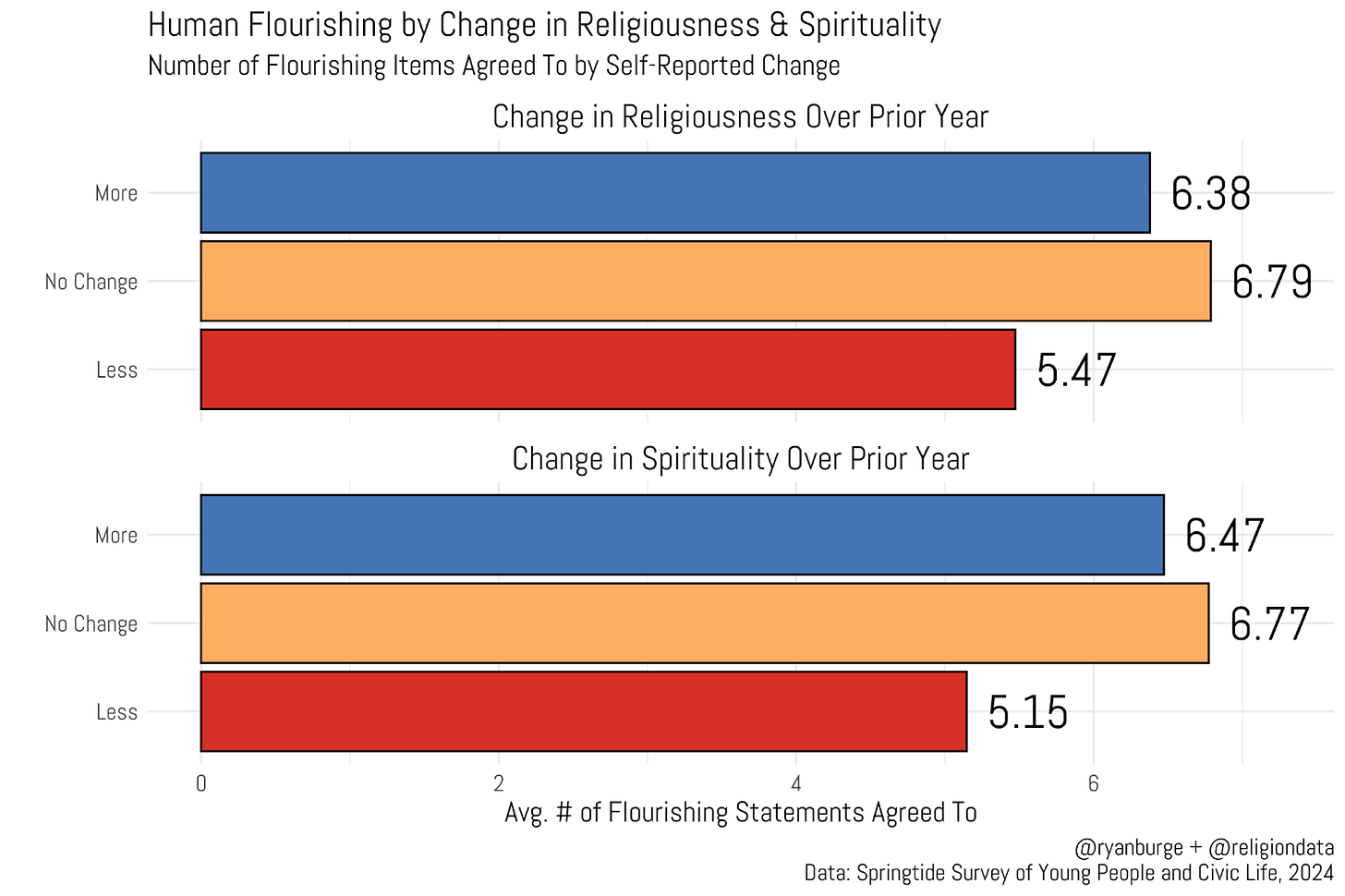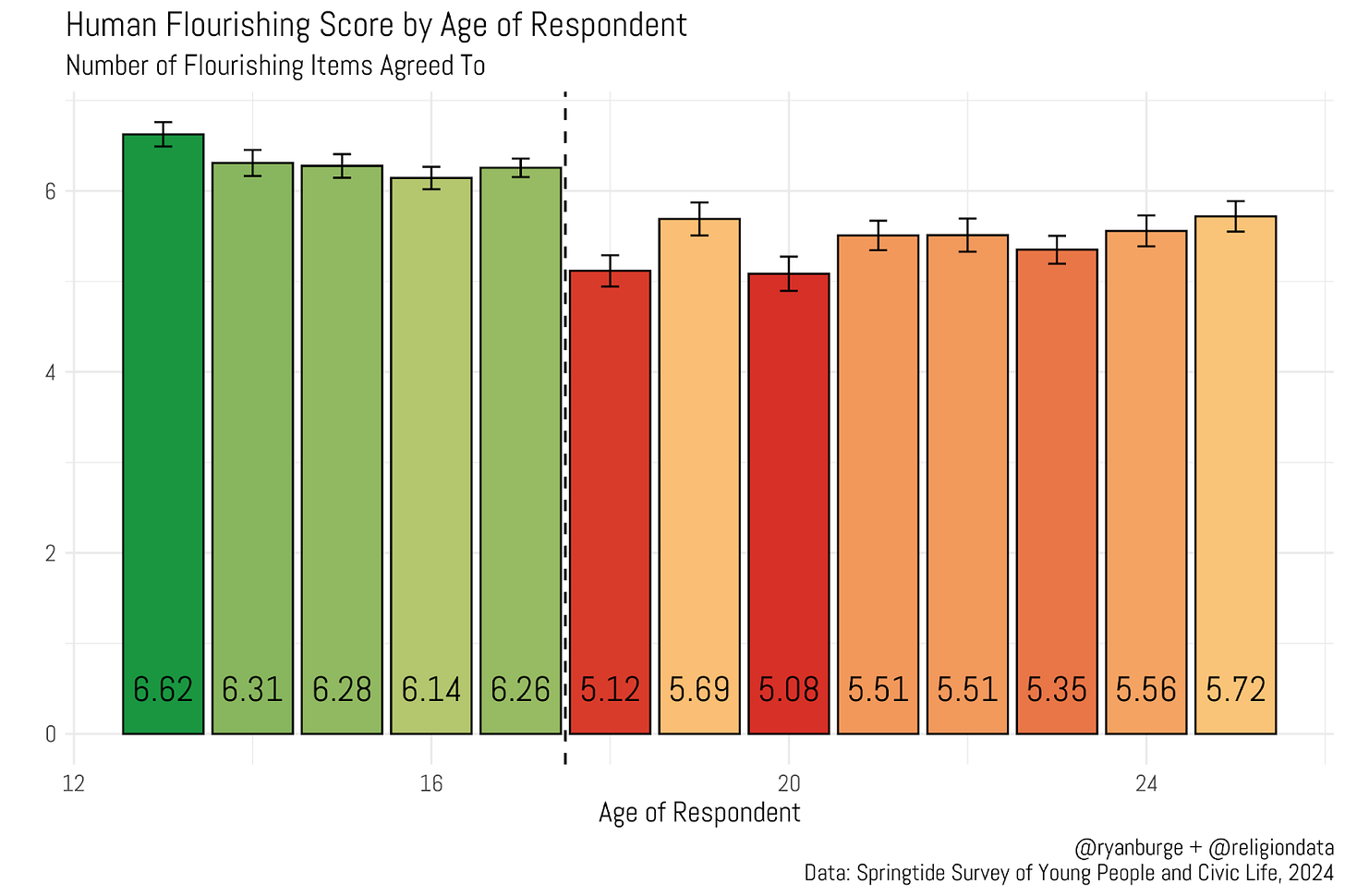Flourishing or Floundering? How Young People See Their Lives
And what role does religion and/or spirituality play in this?
This post has been unlocked through a generous grant from the Lilly Endowment for the Association of Religion Data Archives (ARDA). The graphs you see here use data that is publicly available for download and analysis through link(s) provided in the text below.
One of the most interesting lines of survey research in the last couple of years has been led by Tyler VanderWeele at Harvard. It’s focused on a fairly simple but incredibly consequential aspect of life - human flourishing. VanderWeele has proposed five different dimensions of this concept: happiness and life satisfaction, physical and mental health, meaning and purpose, character and virtue, and close social relationships. What intrigues me about this work is that its focus is not just economic success or physical health - it goes beyond those things. Character matters here. So does leading a life that has some type of larger meaning.
To put it bluntly, Vanderwheele doesn’t leave out the idea of a spiritual and/or religious dimension when it comes to living a good life. And what’s even more tantalizing for someone like me is that lots of other agencies and survey firms have adopted a lot of the human flourishing questions and incorporated them into their own work. For instance, the Global Flourishing Study interviewed over 200,000 respondents across 20+ countries and territories asking them questions from the Flourishing battery. Now we can assess if some cultures tend to do better on these metrics than others and try to figure out what generates these disparities.
The Religion of America's Young Adults
There’s a lot of helpful data here for folks who work with youth, young adults, and college students. If you fit that criteria, get in contact with me and I can provide a discount code for 20% off an annual subscription.
In addition to the Global Flourishing Study, there are groups in the United States that are including Flourishing questions. For instance, the Association of Religion Data Archives just added a survey that was administered by the Springtide Research Institute that polled young people aged 13-25 years old. That’s an incredibly valuable piece of data because it’s methodologically very difficult to ask questions of respondents who are under the age of 18. This means we can really trace human flourishing from kids who are in middle school all the way through to adults in their mid-twenties. I think we can all admit that those years can be chaotic, turbulent, joyous, and often soul crushing.
Let me first show you the responses of the entire sample to eight questions related to human flourishing. They include things like, “I live a purposeful and meaningful life” and “People respect me.”
This data gives an incredibly rosy picture of the flourishing of young adults in the United States. I was pretty shocked by just how much these respondents felt like they were living a good and purposeful existence. For instance, about three quarters agreed that, “my social relationships are supportive and rewarding.” Also, 83% said that “I am competent and capable in the activities that are important to me.” There wasn’t a statement on the list where less than three quarters of the sample agreed or strongly agreed. That’s a whole lot of flourishing, really.
However, there were some questions where young respondents reported slightly lower scores. For instance, just 23% of young people strongly agreed that “people respect me” and only 24% strongly agreed that “my social relationships are supportive and rewarding.” But on the other hand, there’s almost no one in the disagree/strongly disagree side of these graphs. It’s just really hard to find any evidence here that a significant portion of young people don’t feel respected, cared for, or purposeful. Again, I think this is an overwhelmingly positive result.
But what role does religious and/or spirituality play in generating more or less human flourishing? The survey asked respondents “How religious are you?” and “How spiritual are you?” Each question had four response options ranging from ‘not at all’ to ‘very’. I calculate the average number of the flourishing statements agreed to across the full range of religion and spirituality.
The first thing that jumps out is that both religion and spirituality tend to be positively related to human flourishing. Among those who said religion was not at all important to them, the average human flourishing items agreed to was 5.76. For ‘not at all’ spiritual people it was 5.46. But as both religion and spirituality increases, so does flourishing. And that difference is both substantively and statistically significant. For those who were very religious, the flourishing score was 6.6. For the very spiritual group it was 6.7.
On this metric can we say with any certainty whether religion is more effective than spirituality in generating higher flourishing scores? I don’t think we can, honestly. The differences in comparing each level in the two graphs reveals a very small numeric difference. In many cases it’s a tenth of a point. It’s just not a difference that could likely be perceived by folks in their everyday lives. The upshot is simply both religiosity and spirituality are positively related to flourishing.
However, as is always the case with any kind of work like this - correlation is not causation. Yes - people who say that they are more religious report higher flourishing scores, but it could be some confounding variable. For instance, a predisposition towards positivity may lead one to be both more religious and also more apt to report more flourishing. And there’s also the issue of social desirability bias - religious or spiritual people feel like they should be flourishing more even if they don’t think that they are actually doing well. They give the ‘right’ answer not the ‘true’ answer. Figuring out causality here is really difficult.
With those qualifications in mind, let’s go one layer deeper on these two dimensions and do a heat map that visualizes all sixteen permutations of the above questions of religious importance and spiritual importance. That could provide quite a bit more nuance.
Okay, now I think we are beginning to see how both these dimensions tend to work in similar (but not exactly the same) ways when it comes to human flourishing. The top right is clearly the location where we observe the highest flourishing scores. Young people who are both very religious and very spiritual report the greatest feelings of satisfaction, purpose, etc. The corollary to that is the bottom left, of course. The lowest levels of flourishing are among younger people who aren’t spiritual or religious.
There is one more thing that can be lost if you don’t stare at this heat map for a bit. I want you to look at the top left and find the people who are slightly religious and very spiritual. Their flourishing score is 6.36. Now look at the opposite of that - people who are very religious but only slightly spiritual. Their score is just 5.24. That’s a huge numeric difference. I think there’s some evidence here that those who score high on religion and low on spirituality have less flourishing than those who are highly spiritual but not that religious.
Okay, let me pivot to another interesting question that asked respondents how much their religiousness or spirituality has changed over the last year. They could say that they have become more, less, or there was no change in the prior 12 months. I had a hunch that maybe young folks who became more religious or more spiritual may have also reported a pretty high flourishing score.
Okay, these results tell a pretty interesting story about how change impacts flourishing. In both cases, the group that clearly had the highest score were respondents who did not report a big change in either dimension. Which, if you step back and think about it for a minute, does make some kind of sense. More stability is related to more flourishing. Having a lot of big swings in spirituality or religion could be indicative of living a chaotic life. Chaos seems pretty antithetical to flourishing in my mind.
But what about the people who did report a change? Well, I think that the big takeaway for me is that when young people say that they have become less religious or less spiritual, that’s a warning sign when it comes to flourishing. Among young people who said that they were less spiritual now than a year ago, the flourishing score was just 5.15 - easily the lowest of any of the groups. But, the other side of this is that when young people increased their spirituality or religiosity, that didn’t lead to a huge amount of flourishing. Here’s a possible explanation - these respondents became more spiritual because they weren’t really doing well in their life satisfaction and they still haven’t reaped those flourishing rewards quite yet.
Again, a heatmap may be instructive.
I think this graph really comports with what we observed above - consistency leads to flourishing. The square with the highest flourishing score is the young people who didn’t change their religiosity or spirituality in the prior year. The second highest score were respondents who said they were both more religious and more spiritual today than a year ago. That all tends to track for me.
The bottom row is where flourishing is absolutely the lowest. These are people who have become less spiritual over time. I was struck by how little religiosity mattered for these folks. Even among those who became more religious, flourishing was really really low. Compare that to the top row and you can see that for 13-25 year olds, becoming more spiritual seems to be strongly related to flourishing more.
Let me just show you a quick regression now that tries to figure out which factors lead to more or less flourishing.
Everything is statistically significant here. There were four factors that predicted a higher flourishing score: being white, having a greater household income, being more spiritual and being more religious. The variable with the largest positive effect was race. I am struck by how the coefficients for spirituality and religion are not statistically different from one another. Said another way - increases in either lead to more flourishing. One is not preferable to the other here.
The Religiosity of High School Seniors, 1976-2022
There’s this concept in venture capital called a “moat.” The basic idea is straightforward: if a founder approaches a VC firm seeking investment, they need to answer a simple question, "Why can't someone else come in and quickly replicate what you are doing?" Think of a moat around a medieval castle. It's significantly harder to breach the walls when one must traverse a body of water first.
There are two variables that lead to less flourishing. All things being held equal, older respondents score lower on flourishing than younger ones. The other is gender. On balance, a young man is less likely to flourish than a young woman. That’s even true after we control for things like race, income, and level of religiosity or spirituality.
That age result really stuck with me, though. So let me show you this final graph which tells an incredibly compelling story.
I made a line of demarcation at the clear inflection in the data. It is absolutely the case that 13-17 year olds indicate a significantly higher level of flourishing than 18-25 year olds. I mean you can see it as clear as day when comparing a 17 year old to an 18 year old - the difference in flourishing score is 6.3 vs 5.1. While the score does tend to creep up for respondents in their mid-twenties, it’s still half a point lower than someone who is 14 or 15.
This is what really shines through for me - 13 to 17 year olds are doing pretty well. Then things are a whole lot worse for 18 to 25 year olds. We talk a lot about the problems facing teenagers, but we seem to ignore what happens to young people in their early twenties. They leave the stability of their home, many take on student loan debts, they wrestle with making their way in life. According to this survey, it’s certainly an incredibly fraught period of life.
Diagnosing the problem is a big part of what we do. Trying to find ways to increase flourishing is a much more difficult task.
Code for this post can be found here.













Your “graphs” and commentary continue to inspire me, Ryan! Your work on women and religious disaffiliation I cite in a new publication through Wipf And Stock, a book version of my Substack serial, Eight Trails.
Another fascinating post as usual. However, should flourishing be the goal for 18 to 25 years olds? Those times were a period of struggle and pain which I attribute to developing perseverance to handle greater challenges in life. I’m not sure flourishing should be a goal during that period of life…although I might have said it was a goal at the time, I wouldn’t trade the hardships I experienced now I can see how they have helped me weather life.